数据结构(二) --- 伸展树(Splay Tree)
文章图片和代码来自邓俊辉老师课件
概述
伸展树(Splay Tree),也叫分裂树,是一种二叉排序树,它能在O(log n)内完成插入、查找和删除操作。它由丹尼尔·斯立特Daniel Sleator 和 罗伯特·恩卓·塔扬Robert Endre Tarjan 在1985年发明的。(出处百度百科)
它的操作就是将访问到的元素放在根节点处。主要的操作就是 zip 和 zag
下面是空间/时间复杂度(出处)
算法分析
双层伸展
双层伸展的作用是提升了树平均的访问性能。构思的精髓 : 向上追溯两层,而非一层。 右下角是伸展树需要处理的四种情况。具体的处理是怎么样的呢?
双层伸展主要在 zig-zip 和 zag-zag 的情况下发挥作用,例如要使v 升到根节点,双层伸展要求我们使用先对祖父节点zig,然后再做一次zip ,即是下部分三幅图演示的那样。下面我们看一下使用这种方法真的可以提升性能吗。
分摊性能
我们可以看到左边是逐层调整的方法,而右边是双层调整的方法,右边的子树的高度很明显比左边的矮了一半,当下一次又遇到最坏节点时,由于高度矮了一半了,那么性能自然就提升了。所以平均分摊时间可以达到 logn .
算法实现
代码是根绝邓老师的提供的代码用java改写的,添加了部分注释
主要处理的四种情况可以详见下面的代码
1 package Splay; 2 3 4 public class Node { 5 Node left; 6 Node right; 7 Node parent; 8 int value; 9 10 public Node(int value) { 11 this.value = value; 12 } 13 14 public boolean isLeftChild() { 15 return parent != null && (parent.left == this); 16 //根节点,我们直接返回false 17 } 18 19 public boolean isRightChild() { 20 return parent != null && (parent.right == this); 21 //根节点,我们直接返回false 22 } 23 24 @Override 25 public String toString() { 26 return "该节点的值为:" + value + " 左节点:" + ((left!=null)? left.value:"无") + " 右节点:" + ((right!=null)? right.value:"无") + " 父节点:" + ((parent!=null)? parent.value:"无"); 27 } 28 } 29
1 package Splay; 2 3 4 import com.sun.org.apache.bcel.internal.generic.IF_ACMPEQ; 5 6 import javax.management.modelmbean.ModelMBean; 7 8 /** 9 * Splay Tree (伸展树) 10 * 11 * 12 */ 13 public class SplayTree { 14 15 public Node root; 16 17 /** 18 * @param val 插入节点的值 19 */ 20 public Node insert(int val) throws Exception { 21 if (root == null) { 22 root = new Node(val); 23 return null; 24 } 25 Node node = search(val); 26 //search操作查找是否存在该节点 27 if (node.value == val) { 28 return node; 29 } else { //search操作找不到该节点,查找返回的是hot节点,插入的节点再和hot重新装配 30 Node newRoot = new Node(val); 31 if (val > node.value) { 32 node.parent = newRoot; 33 newRoot.left = node; 34 newRoot.right = node.right; 35 if (node.right != null) { 36 node.right.parent = newRoot; 37 node.right = null; 38 } 39 } else { 40 node.parent = newRoot; 41 newRoot.right = node; 42 newRoot.left = node.left; 43 if (node.left != null) { 44 node.left.parent = newRoot; 45 node.left = null; 46 } 47 } 48 root = newRoot; 49 return newRoot; 50 } 51 } 52 53 /** 54 * 删除某个节点 55 * @param val 删除的节点 56 * @return true 成功删除,反之 57 */ 58 public boolean delete(int val)throws Exception{ 59 Node node = search(val); 60 if (node.value == val) { //找到该节点 61 if (node.left == null) { //没有左子树 62 root = node.right; 63 node.right.parent = null; 64 node.right = null; 65 } else if (node.right == null) { //没有右子树 66 root = node.left; 67 node.left.parent = null; 68 node.left = null; 69 }else { //节点存在左右子树 70 //暂时切除左子树,然后右子树中最小的节点,在连接起来 71 Node lTree = node.left; 72 lTree.parent = null; 73 root.left = null; 74 search(node.value); 75 //最小的节点必然上升到了根节点,此时的root应该是右子树中最小的节点 76 root.left = lTree; 77 lTree.parent = root; 78 node = null; //原来的节点置null 79 } 80 return true; 81 }else { 82 return false; 83 } 84 } 85 86 /** 87 * 计算整个树的高度 88 * 89 * @return 90 */ 91 public int height() { 92 Node node; 93 int lh = 1, rh = 1; 94 node = root.left; 95 while (node != null) { 96 lh++; 97 node = node.left; 98 } 99 100 node = root.right; 101 while (node != null) { 102 rh++; 103 node = node.right; 104 } 105 106 return Math.max(lh, rh); 107 } 108 109 /** 110 * 中序递归打印 111 * @param node 112 */ 113 public void printMidNum(Node node) { 114 if (node != null) { 115 printMidNum(node.left); 116 System.out.print(node.value + " "); 117 // System.out.println(node.toString()); 118 printMidNum(node.right); 119 } 120 } 121 122 123 /** 124 * @param value 使用伸展策略搜寻的某个值, 125 * @return 返回查找到的node, 树中没有该元素返回null 126 */ 127 public Node search(int value) throws Exception { 128 /* 129 搜索某个节点是不是存在,调用splay方法 130 */ 131 Node compare; 132 Node target; //目标节点 133 Node hot = null; //目标附近节点 134 compare = root; 135 136 if (compare == null) { 137 throw new Exception("该树为空树"); 138 } 139 //查找某个节点 140 while (true) { 141 if (compare == null) { 142 target = null; 143 break; 144 } else if (compare.value == value) { 145 target = compare; 146 break; 147 } 148 if (compare.value > value) { 149 hot = compare; 150 compare = compare.left; 151 } else { 152 hot = compare; 153 compare = compare.right; 154 } 155 } 156 157 if (target == null) { 158 root = splay(hot); 159 return null; 160 } 161 162 return (root = splay(target)); 163 } 164 165 166 public void attachAsLChild(Node parent, Node lChild) { 167 parent.left = lChild; 168 if (lChild != null) 169 lChild.parent = parent; 170 } 171 172 void attachAsRChild(Node parent, Node rChild) { 173 parent.right = rChild; 174 if (rChild != null) 175 rChild.parent = parent; 176 } 177 178 /** 179 * 传入的 v 必须存在于树中,由调用的方法保证 180 * splay 方法针对情况进行转换,转换的思路是重新对各个节点的位置装配,装配的意思指的是 181 * 根据初始的位置和最终的位置拆解-重连的操作 182 * 183 * @param v v为因最近访问而需伸展的节点位置 184 * @return 调整之后新树根应为被伸展的节点,故返回该节点的位置以便上层函数更新树根 185 */ 186 public Node splay(Node v) { 187 if (v == null) return null; 188 //*v的父亲与祖父 189 Node p; 190 Node g; 191 while ((p = v.parent) != null && (g = p.parent) != null) { //自下而上,反复对*v做双层伸展 192 Node gg = g.parent; //每轮之后*v都以原曾祖父(great-grand parent)为父 193 if (v.isLeftChild()) { 194 if (p.isLeftChild()) { //zig-zig 195 attachAsLChild(g, p.right); 196 attachAsLChild(p, v.right); 197 attachAsRChild(p, g); 198 attachAsRChild(v, p); 199 } else { //zig-zag 200 attachAsLChild(p, v.right); 201 attachAsRChild(g, v.left); 202 attachAsLChild(v, g); 203 attachAsRChild(v, p); 204 } 205 } else if (p.isRightChild()) { //zag-zag 206 attachAsRChild(g, p.left); 207 attachAsRChild(p, v.left); 208 attachAsLChild(p, g); 209 attachAsLChild(v, p); 210 } else { //zag-zig 211 attachAsRChild(p, v.left); 212 attachAsLChild(g, v.right); 213 attachAsRChild(v, g); 214 attachAsLChild(v, p); 215 } 216 217 //重连子树,并判断是否loop是否结束 218 if (gg == null) 219 v.parent = null; //若*v原先的曾祖父*gg不存在,则*v现在应为树根 220 else //否则,*gg此后应该以*v作为左或右孩子 221 if (g == gg.left) { 222 attachAsLChild(gg, v); 223 } else { 224 attachAsRChild(gg, v); 225 } 226 227 } 228 //双层伸展结束时,必有g == NULL,但p可能非空,即是目标到根节点之间还有一个节点,需要一次单旋解决 229 if ((p = v.parent) != null) { 230 if (v.isLeftChild()) { 231 attachAsLChild(p, v.right); 232 attachAsRChild(v, p); 233 } else { 234 attachAsRChild(p, v.left); 235 attachAsLChild(v, p); 236 } 237 } 238 v.parent = null; 239 return v; 240 } 241 242 243 } 244 245 246
代码中的注释已经说明了各个操作的流程,需要注意的是insert 和 delete方法,由于这两个方法在实现的时候都会先调用search方法,我们使用了一个hot 节点,表示离目标节点最近的节点,让hot 节点上升到根节点,方便我们在insert和delete后续的使用。
综合评价
不能保证单次最坏情况的出现的原因是,假如我们一开始要找的那个点就在最底下,那么就可能达到了最坏的情况。
参考资料
- 邓俊辉老师的数据结构课程

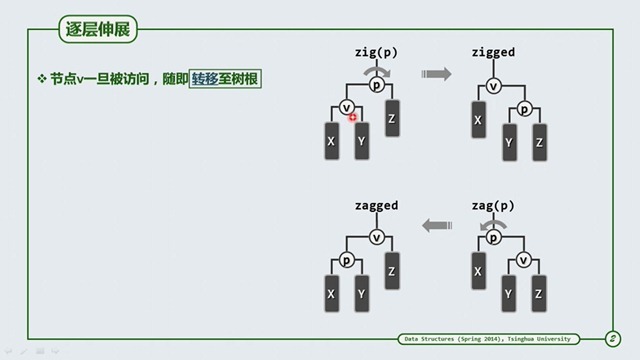
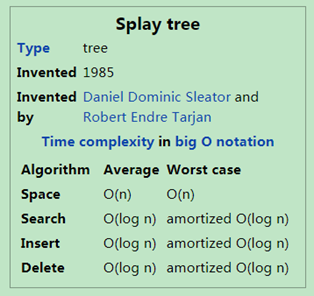
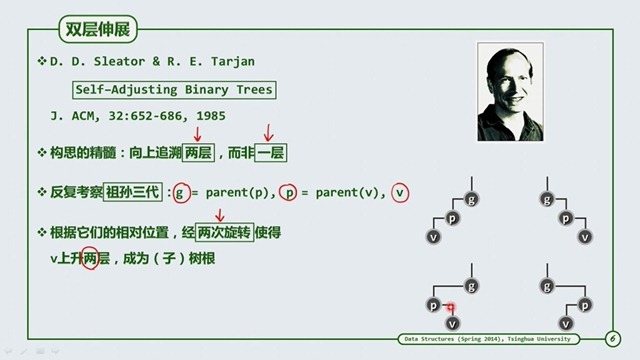

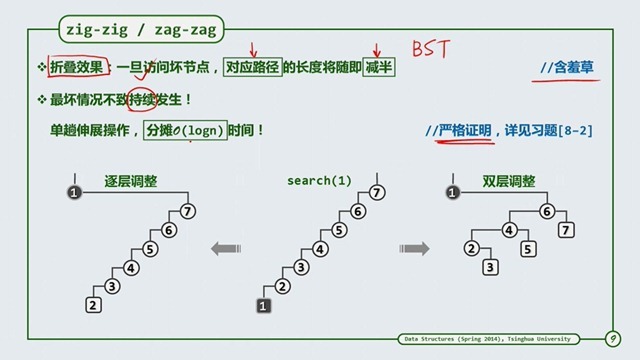
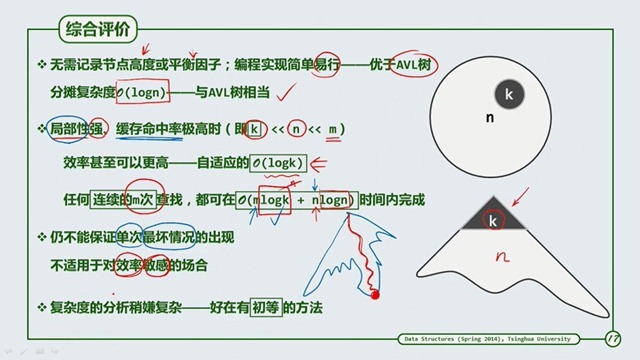

 浙公网安备 33010602011771号
浙公网安备 33010602011771号